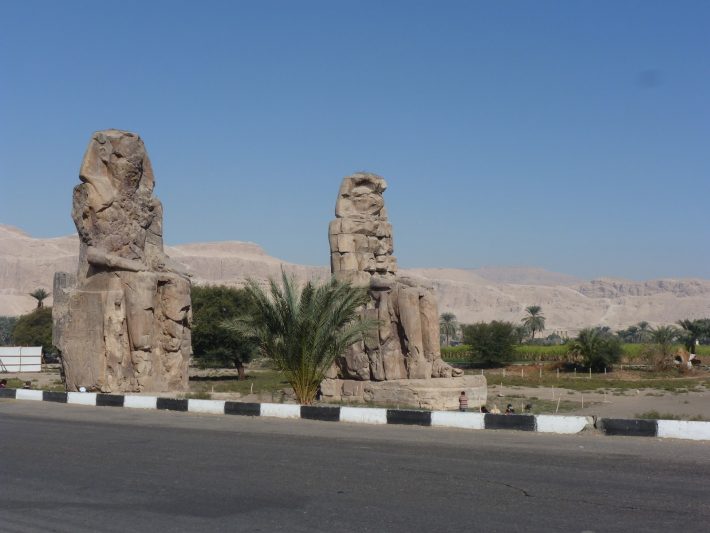Further blogs from our visit to Egypt for Christmas, a three day trip to Luxor, staying at the charming Jolie Ville Hotel overlooking the Nile. This time “then and now’s” with a literary connection and a hint of restitution an the end.
The Colossi of Memnon
The two huge statues of the Pharoah Amenhetep III [1390-1353 BC] were, I feel, the inspiration for the first lines of the famous poem Ozymandias by Percy Bysse Shelley [1792-1822] The statues are all that is left of the Memorial Chapel of Amenhetep on the West Bank of the Nile at Luxor, previously Thebes.
“I met a traveller from an antique land
Who said: Two vast and trunkless legs of stone
Stand in the desert…..”
They were first illustrated by Frederick Norden in 1737, then, left, in Napoleon’s Description d’Egypt in 1793
| December 2011 |
The Ramesseum
 |
| Description d’Egypt, 1798 |
 |
| The Rameseum of El-Kurneh by Francis Frith 1857 |
 |
| David Roberts, 1837/38, with a certain exageration of the statue’s features. |
| December 2011 |
Below a general view of the Ramesseum by Norden in 1737 with the fallen visage of Ramsess II on the right. The figure on the ground in the middle between the four Osirid statues could the the bust removed by Belzoni mentioned below.
| The Vestibule Gallery with the lower section of the Statue of Rameses II |
| Close up |
| Upper section of the Statue of Rameses in the British Museum |
The arrival of the statue in London and publication of Belzoni’s activities, to much excitement, inspired Shelley’s Ozymandias, a Greek rendering of one off Rameses II names; User-Ma’at-Ra. Whether it was this statue or the fallen visage still remaining in the temple, and illustrated above, is a moot point.
The poem continues ;
Which yet survive, stamped on these lifeless things,
The hand that mocked them, and the heart that fed.
And on that pedestal these words appear
“My name is Ozymandias, King of Kings:
Look on my works, ye mighty, and despair!.
Nothing beside remains. Round the decay
of that colossal wreck, boundless and bare
The lone and level sands stretch far away.
In his excellent book “The Illustrated Guide to Luxor” Kent R. Weeks states that ” Seventeen centuries before Shelley, Diodorus Siculus had wrongly claimed to have seen an inscription on the fallen statue that read:” I am Ozymandias, King of Kings; if any would know how great I am, and where I lie, let him excel in any of my works”.




